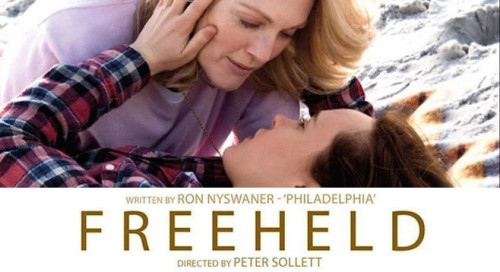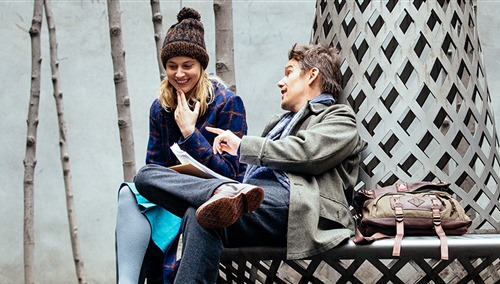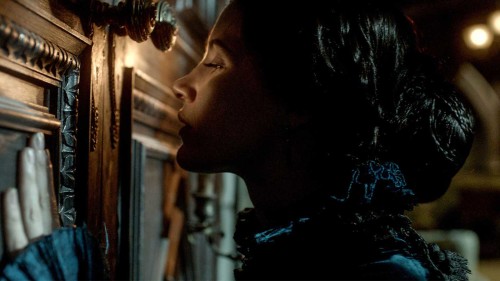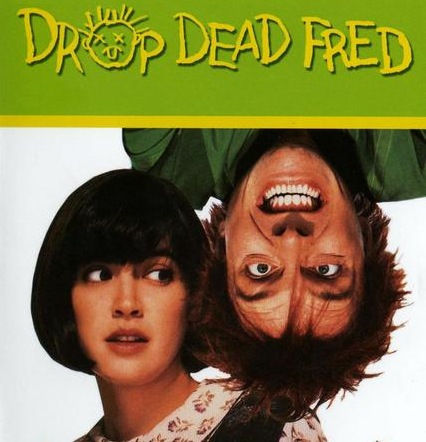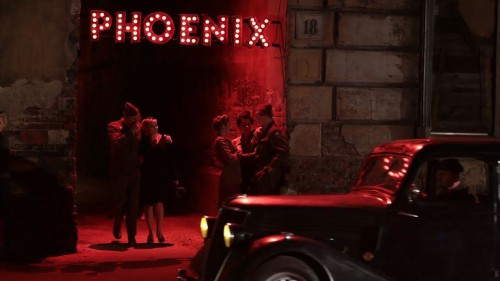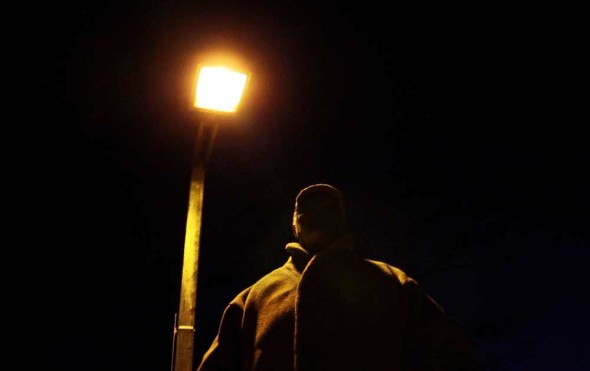This is a guest post by Amy Woolsey.
You can scarcely read a review of Phoenix, the latest movie by German director Christian Petzold, without encountering a reference to Vertigo. Like Alfred Hitchcock’s 1958 classic, Phoenix deals with trauma, mistaken identity, and male authority. Stylistically, it leans more toward restraint than melodrama, but it still makes use of double imagery and lush colors (red in particular) to create a surreal atmosphere that drifts through each frame like cabaret music onto nighttime streets.

As in Vertigo, red suggests romance – and danger.
Both films also include a woman who comes back from the dead. In Vertigo, Kim Novak’s Madeleine Elster inflames the passion of Jimmy Stewart’s ex-detective Scottie Ferguson, only to apparently commit suicide halfway through the movie by jumping off a bell tower. Later, the grief-stricken Scottie runs into a woman named Judy Barton who reminds him of Madeleine, and he grows obsessed with molding her into his former lover’s likeness. It turns out that the two women are the same person: Judy had been impersonating Madeleine as part of an elaborate murder scheme. In Phoenix, Nina Hoss plays Nelly Lenz, a Holocaust survivor who gets surgery to reconstruct her mutilated face. When she reunites with her husband Johnny (Ronald Zehrfeld), he doesn’t recognize her, but noticing a resemblance, he convinces her to masquerade as his “dead” wife so they can collect and split her inheritance.
The similarity isn’t a coincidence. Petzold, along with late screenwriter Harun Farocki, deliberately designed Phoenix as “Vertigo in reverse,” as he explained in an interview with The Film Stage:
“We always thought about the male perspective. We always thought about a man who creates a woman, but we never thought about the perspective of a woman… It was Harun that said we had to change the perspective, so we started thinking about what the male subjectivity had done to Kim Novak, and the studio system — to the actor and to the character in Vertigo. Why all these stories are made by men, huh?”
Far from a cheap gimmick, the point-of-view switch in Phoenix sheds new light on Vertigo and film noir, demonstrating how the genre has evolved since its World War II-era heyday.
As a genre, noir is somewhat nebulous. The term did not enter popular usage until the 1970s, applied in retrospect to a set of films from the 1940s and ‘50s with similar aesthetic and thematic qualities. Some critics don’t consider it a genre at all, but rather a cycle or style. Still, there are a number of conventions commonly associated with noir, from dramatic lighting that emphasizes shadows to a gloomy, even nihilistic mood, not to mention archetypes such as the world-weary detective and, most notably, the femme fatale – in the words of Roger Ebert, a woman who’d “just as soon kill you as love you, and vice versa.”

Barbara Stanwyck epitomizes the femme fatale as Phyllis Dietrichson in Double Indemnity.
Vertigo was released at the tail end of the classic noir period, but Madeleine Elster still displays the characteristics of a quintessential femme fatale. Slender, white, and platinum-blond, she has a statuesque, if patently artificial beauty, her face blank in a way that conveys mystery rather than vacuity – a discomfiting amalgam of sensuality and reserve. Yet even as she emanates danger, an air of tragedy surrounds her. Madeleine is doomed from the moment she appears onscreen; we’d already heard Gavin, her husband, speculate that she’s being possessed by the ghost of her suicidal great-grandmother, causing her to act “like someone I don’t know.” She may be an agent of death, but she’s also captive of it, perpetually haunted by the specter of her mortality. At one point, she tells Scottie that she feels “as though I’m walking down a long corridor that once was mirrored… and when I come to the end of the corridor, there’s nothing but darkness. And I know when I walk into the darkness that I’ll die.”
The femme fatale, then, embodies noir’s obsession with death – not only its inevitability but also its allure. Unlike the male hero, who strives to defy fate at every turn, the femme fatale is acutely aware of her vulnerability. As scholar Elisabeth Bronfen posits, she “accepts her death as the logical consequence of her insistence on a radical pursuit of personal freedom,” embracing ruin rather than wallowing in denial. It isn’t passivity so much as cynicism; as a woman in a patriarchal society, she’s familiar with the limits of autonomy and has no illusions of grandeur or righteousness. Judy describes her reunion with Scottie as “the moment I dreaded and hoped for,” suggesting she expected and possibly wanted to be found (she did stay in San Francisco and keep several items of clothing she’d worn as Madeleine). She accepts the immorality of her actions and the futility of avoiding retribution.
In theory, Madeleine’s “suicide” should humble Scottie, a reminder of his own vulnerability. But being a noir hero, he shuns enlightenment and clings to the very American, very masculine belief that individuals have absolute mastery over their destinies and the world around them. His efforts to manage Judy stem from not only male hubris, but also an obsessive need to regain a sense of control and repel knowledge of life’s impermanence. Instead of directly confronting his guilt and failure, he deflects blame onto Judy, convinced that by vanquishing her, he can attain redemption and subdue his inner turmoil. While driving back to the bell tower where Madeleine died, Scottie declares, “There is one final thing I have to do and then I’ll be free of the past.” Novak’s dubious expression articulates what her character has no doubt learned: you can’t escape the past.
A more prevalent interpretation of the femme fatale reads her as a male fantasy, a screen onto which spectators can project their erotic desires. Although the narrative often penalizes the hero for succumbing to lust, it implicitly encourages the audience to participate in his temptation, establishing his point-of-view as dominant and rarely developing the woman beyond her surface. As Laura Mulvey’s oft-cited male gaze theory goes, men look, while women are looked at. Is it any wonder that the most memorable image from Vertigo is a shot of Madeleine sitting in front of a painted portrait, her back to the camera? She’s anonymous, part of the surrounding artwork. In this case, the femme fatale doesn’t personify fate but transcends it, her temporary demise and subsequent resurrection reinforcing her abstract nature – her fluid identity, otherworldly glamour, and general elusiveness. She’s not mortal because she’s not real. If that sounds contradictory to the “femme fatale as the essence of mortality” theory, it’s because the femme fatale is a fundamentally contradictory figure: elegant yet violent, volatile yet cunning, egocentric yet self-destructive, catering to female empowerment yet also male pleasure.

Hitchcock frames Madeleine herself as a work of art.
At Vulture, Angelica Jade Bastién lamented that noir has shriveled into an empty shell of its former self, tending to appropriate the genre’s most superficial aspects (the violence, the hardboiled dialogue) while neglecting its underlying meaning (the commentary on power, sexuality, deviance, and the American Dream). As a result, the femme fatale has lost much of her potency. Her influence is visible in the demented predators of psychosexual thrillers like Fatal Attraction and Basic Instinct and the ravishing, albeit ultimately harmless sirens of neo-noirs like L.A. Confidential and Drive, but these characters lack their predecessors’ complexity and subversive edge. Along with David Fincher and Gillian Flynn’s twisted romance Gone Girl and Alex Garland’s sleek science-fiction parable Ex Machina, Phoenix takes strides toward salvaging the modern femme fatale, playing with perspective in order to deconstruct gender dynamics and genre tropes.
By situating her at the center of the story, Phoenix grants Nelly an agency Madeleine was denied, turning her into a fully realized individual with her own arc and interior life instead of a mere manifestation of the male hero’s subconscious. Behavior that could come across as illogical and contrived makes sense because Petzold exhibits genuine interest in understanding Nelly and what drives her. Without compromising subtlety, he peels back the layers of his heroine’s enigmatic façade, hinting at her willful nostalgia (she implores the surgeon operating on her face to make her look how she used to) and simultaneous, conflicting urge to find the truth about her husband. Hitchcock, meanwhile, never bothered to devise an explanation for why Madeleine/Judy goes along with Gavin’s plan to murder his wife; she just does what the plot requires of her.
It’s clear right away that Nelly is not a conventional femme fatale. She first appears huddled in the passenger seat of a car, her face covered with bandages and shadows – a stark juxtaposition from Madeleine’s introduction in Vertigo, with Scottie furtively eyeing her emerald-clad figure as Bernard Hermann’s score swells. There’s no attempt to hide Nelly’s fragility; as she wanders through the desolate streets of postwar Berlin, she seems to fade into the background, a ghost haunting ruins. Here, the false death illustrates the effects of trauma, the feeling of having witnessed the end of the world and no longer belonging in the present. Johnny’s manipulation isn’t just inconvenient for Nelly; it’s oppressive, a refusal to acknowledge her personhood. When the bandages come off and she undergoes her transformation, Nelly starts to occupy more of the screen, but that initial sense of alienation and repressed anxiety lingers, etched in Hoss’s searching gaze and tentative walk.
Especially telling is the scene where Nelly enters Johnny’s basement, looking like her old self for the first time. The camera establishes a close-up of her shoes before gliding upward, revealing her body in fragments as she descends the stairs. It’s a familiar technique, used to elicit awe at a female character’s appearance in movies as varied as the Bette Davis romance Now, Voyager and the James Bond-esque spy romp Mission: Impossible – Ghost Protocol. In Phoenix, however, the sequence unfolds with an unease that defuses the sensationalism and, as a result, undercuts its effectiveness as a tool of the male gaze. Gone is the mystique that shrouded the femme fatales of classical noir; we’re too conscious of Nelly’s suffering to romanticize her. That’s not to say she is depicted as weak: even at her most ostensibly docile, when Johnny dictates her appearance and movements, Nelly is in command of the narrative. She obtains power not through violence or seduction but knowledge, her willingness to exploit the discrepancy between her real identity and Johnny’s perception of her.

A silent power struggle
Noir is traditionally regarded as the realm of men, with its unsentimental look at crime and corruption. Yet, at its best, the genre has always been as much a portrait of femininity as of masculinity, showing how women navigate and resist the social, moral, and sexual standards imposed on them. After all, one of the reasons for its enduring popularity is its fascination with outsiders, the people lurking in the margins and dark corners of society. Phoenix succeeds where so many have fallen short because it recognizes the value of women’s experiences, presenting a heroine who exists for her sake, not the hero’s, who is neither vilified nor fetishized. At last, the femme fatale manages to transcend the male imagination and become human – free.
Amy Woolsey is a writer living in northern Virginia. Since graduating from George Mason University in May, she has started interning at the Smithsonian National Museum of American History. She spends her free time consuming, discussing, and generally obsessing over pop culture. You can follow her on Twitter and Tumblr, and she keeps a personal blog that is updated irregularly. In addition to freelancing at The Week, she wrote about The Bling Ring for Bitch Flicks’ “Unlikable Women” theme week.
Recommended Reading
The Modern Femme Fatale in Nicolas Wending Refn’s Neo-Noir Drive
No Place for a Woman: The Family in Film Noir
Vertigo by Jim Emerson
Hoss Is Boss: The Enigma of Christian Petzold’s Muse by Scott Tobias
